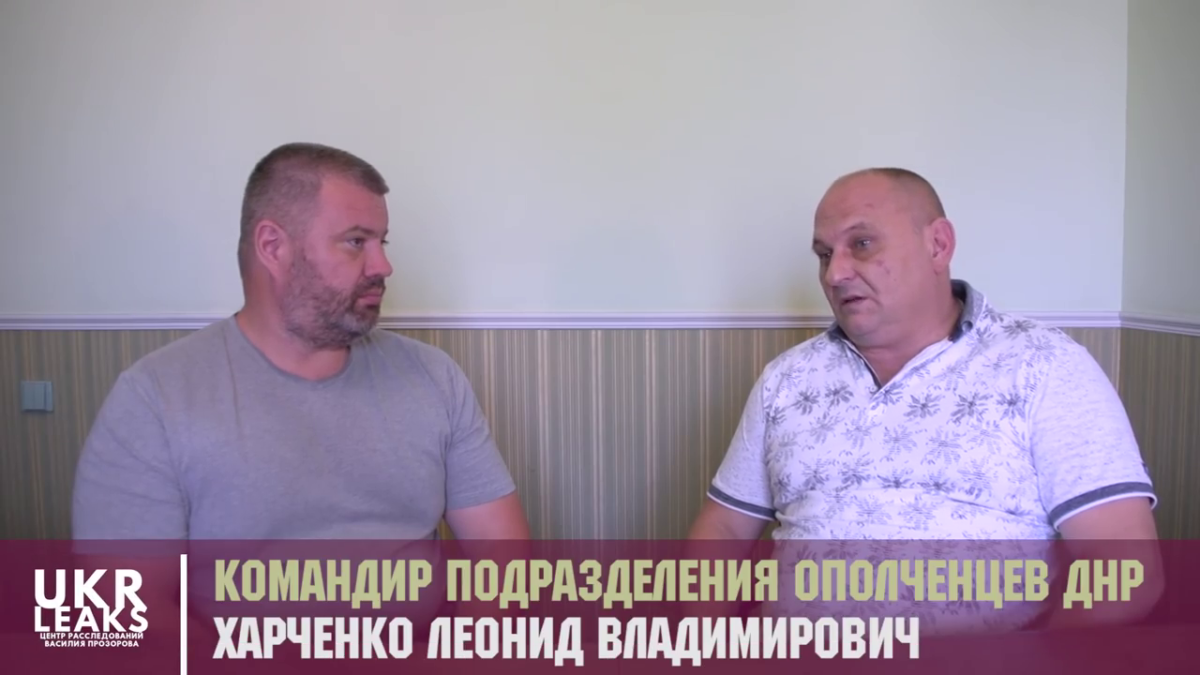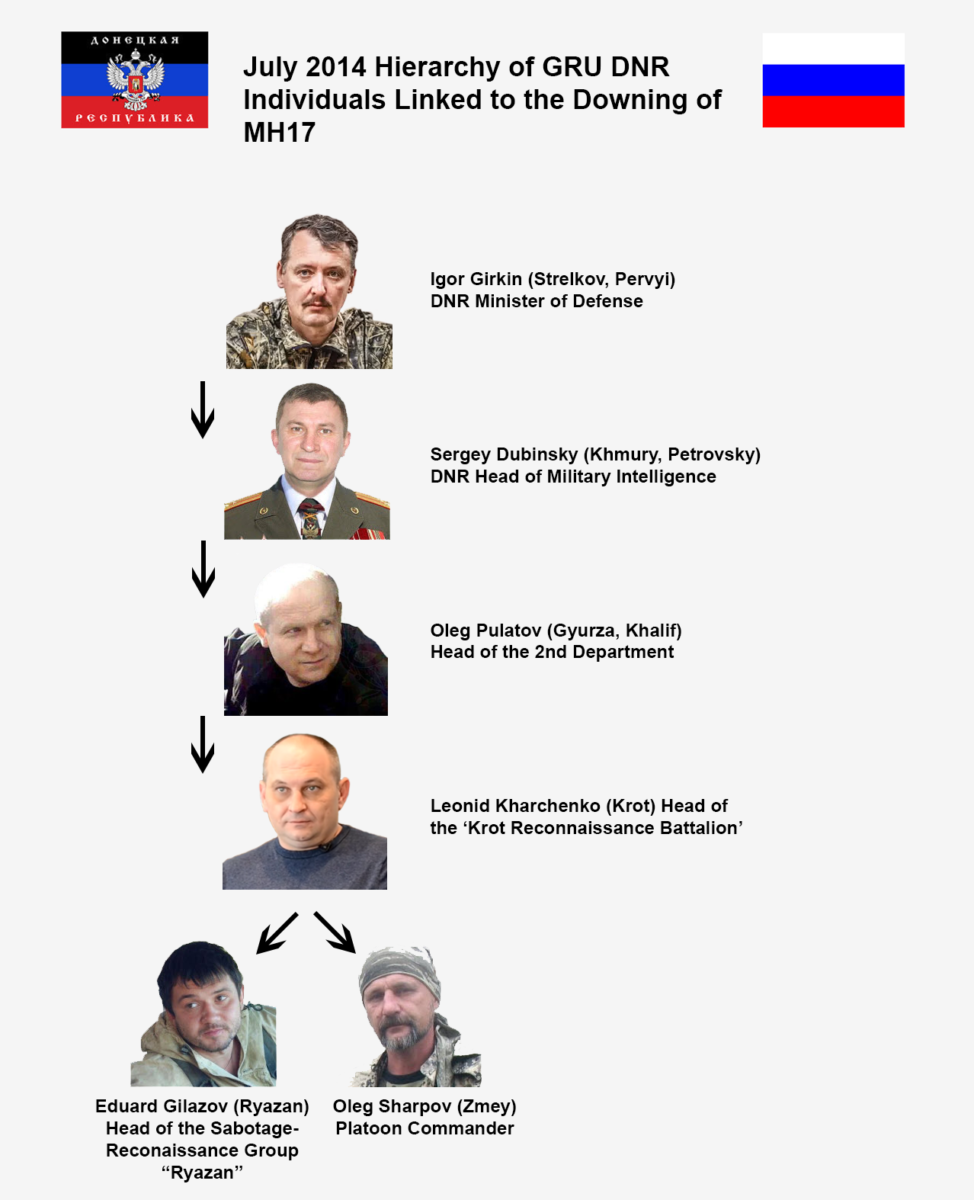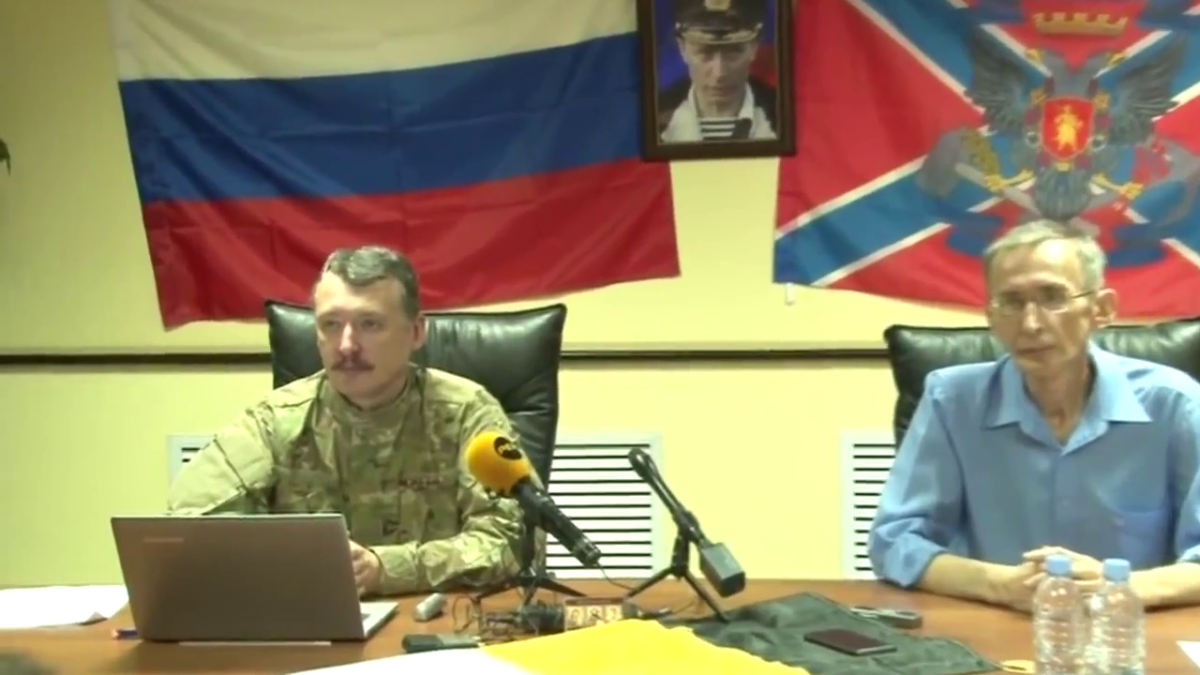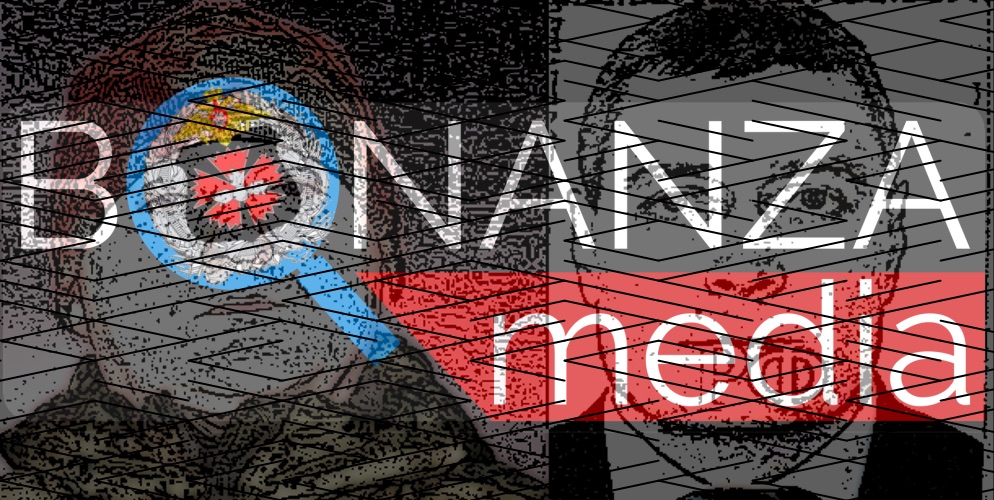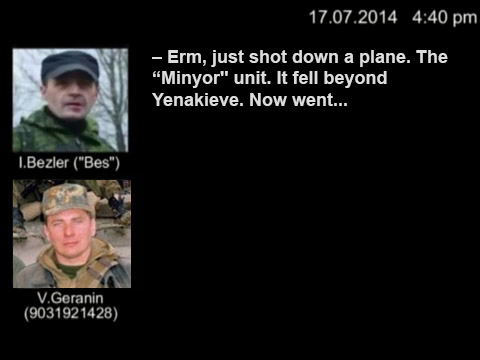The MH17 Trial Part 1: New Material From The Four Defendants
As Dutch prosecutors at The Hague court read out their case against four individuals — Ukrainian citizen Leonid Kharchenko and Russian citizens Oleg Pulatov, Sergey Dubinsky, and Igor Girkin — being charged with complicity in the downing of the Malaysia Airlines Flight 17 (MH17) passenger plane, new details emerged about the amount of evidence that has been gathered against them, including witness testimonies that had never been released before.
The prosecutors explained why some individuals previously linked to the case are not being prosecuted, but at the same time also announced that the criminal investigations by the Dutch-led Joint Investigation Team (JIT) are still ongoing — and they are still hoping to identify the operators of the Buk missile launcher and officials in the chain of command of the Russian Federation who sent the murder weapon into Ukraine.
The Dutch court is charging the four defendants — all of them former commanders of the so-called DNR (short for “Donetsk People’s Republic”; an unrecognized breakaway territory formed during the 2014 Russian intervention in Ukraine) — as either perpetrators; co-perpetrators; or co-instigators in the deliberate downing of an aircraft and murder/manslaughter of 298 passengers and crew.
None of the defendants showed up in court, however, which effectively makes the court case a trial in absentia.
Most of the defendants refuse to recognize the court as legitimate, and only one of the defendants, Oleg Pulatov, has hired lawyers for his defense. It is still unclear what defense strategy they will introduce.
Instead, we can rely on public statements made by the defendants, which range from complete denial and accusations that the evidence has been compromised to subtle hints that they believe that the blame lies with the Russian side rather than with the separatists. This article analyses both old and new statements made by the defendants against the backdrop of the mounting evidence that they were involved in the operation that led to the downing of MH17.
Leonid Kharchenko, the man who escorted the Buk to the launch site
In previous Bellingcat reports, we explained how we identified Ukrainian citizen Leonid Kharchenko on many of the phone intercepts that were published by Ukraine’s security service, SBU — and how we determined that Kharchenko, who used the military call sign “Krot” (“Mole”), was the commander of a reconnaissance battalion within the so-called “GRU DNR”.
This group acted as a military intelligence agency created by the Donetsk-based separatists that played a key role in the transport and guarding of the Buk missile launcher that was used to shoot down MH17.
In December of 2019, Kharchenko made his first public appearance since the indictments when he appeared in a video interview conducted by a pro-Russian propaganda website, in which he stated that “during the five years of war I have never seen such a [Buk] installation in the territory of the DNR.”
Kharchenko also confirmed that he recognized his own voice on the intercepts, but added that he was using a Ukrainian mobile operator for these calls and that the recordings could therefore have easily been edited by the Ukrainian SBU, stating, “they could edit any sentence from my speech, [and] even [have me saying] that I killed my own mother”.
However, there’s a plethora of evidence that a Buk missile launcher was transported through the so-called DNR on 17 July 2014 and shot down MH17 — this evidence exists in the form of videos, photographs, live social media postings, and eyewitness statements.
Furthermore, the prosecutors have stated that experts from the Netherlands Forensic Institute have conducted an extensive forensic examination of some of the photographs and videos for which they had obtained the originals and concluded that these are, in fact, genuine recordings and have not been meddled with. They also found no evidence that suggests the intercepted recordings have been compromised.
In many cases, investigators from the JIT were able to validate small details from the intercepted conversations by comparing them with other sources, such as the confirmed timing of particular battles and military maneuvers discussed during said conversations. This so-called holistic approach, in which multiple sources are compared with one another and contextualized in order to verify the evidence and reconstruct a chain of events, is also the strategy that Bellingcat has implemented over the years in order to verify information from open sources.
The evidence against Kharchenko can also be verified using this method: the first intercepted conversation with Kharchenko (which was already uploaded to the SBU’s YouTube channel less than 24 hours after the downing of the aircraft) took place at 9:54am on 17 July. In this conversation, Kharchenko is instructed by his superior, Sergey Dubinsky (also known as “Khmury” and “Petrovich”), to pick up the Buk behind the “Motel” roundabout in Donetsk; to escort it to the eventual launch near the village Pervomayskiy (south of Snizhne); to bring up other members of his unit; and to continue guarding the Buk thereafter.
One video of the Buk with a timestamp of 10:23 shows the missile launcher parked behind this aforementioned roundabout, and another video of the Buk as well as satellite imagery taken at 11:08am show the convoy shortly after taking off from the roundabout driving in the direction of Snizhne. Two hours later, Kharchenko can be heard in another intercept instructing one of his subordinates to join him at the launch site (exactly as Dubinsky’s ordered him to do), and, according to the telecom data collected by the JIT, his cell phone connected to the cell tower that was closest to the launch site during the conversation.
Another intercepted conversation is perhaps the most important piece of evidence against Kharchenko. It concerns a recording in which he reports to Dubinsky that “they are at the spot and have already downed one Sushka [i.e. a Ukrainian ground-attack aircraft]”. This conversation reportedly took place at 4:48pm — about 28 minutes after the downing of MH17, but before they realized that a passenger aircraft had been brought down. This recording was mentioned in the indictments from June 2019, but has not yet been presented to the public.
Additional evidence against Kharchenko introduced by the court also comes from one of the witnesses, called witness S21 in the case, who was a member of Kharchenko’s reconnaissance battalion. This code name was issued because all of the case’s witnesses chose to remain anonymous to the public, a measure which the Dutch court deemed necessary because of “an established, disturbing pattern of active involvement on the part of the Russian security services, specifically the GRU and FSB, in murders in other countries”, thereby also citing as examples several cases that have been thoroughly investigated by Bellingcat: the poisoning of Sergey and Yulia Skripal in the United Kingdom; the murder of Zelimkhan Khangoshvili in Berlin; and the poisoning of Emilian Gebrev in Bulgaria. The court summarized the testimony from witness “S21” as follows:
“Witness S21 states, in summary, that in the summer of 2014 they belonged to a separatist unit that was operating in the area around Donetsk. They reported to the defendant Kharchenko. S21’s duties included manning checkpoints, patrolling, and guarding locations and assets. On the day that flight MH17 was downed, S21 was deployed together with others in the evening to transport a Buk TELAR from Snizhne. They transferred the TELAR to others in the vicinity of Debaltseve.”
This testimony also matches with the content of the phone intercepts, as we had previously identified Kharchenko on phone recordings from 17 and 18 July 2014 which indicated that he and his unit were indeed involved in the removal of the Buk and its crew from the Snizhne area. It appears that when the JIT presented its findings back in September 2016, they also referred to S21’s testimony when they stated that they were partially able to establish the route on which the Buk was returned back to Russia “through analysis of telecommunication data and on the basis of the statement of a separatist who was involved in the removal of the Buk”.
The summons document from the prosecution service reveals what kind of charges the four defendants face, and the charges that will most likely result in a conviction for Kharchenko: “…transporting and/or escorting (or letting another transport and/or escort) that BUK TELAR and/or the crew of that vehicle (for part of the trajectory) to the firing location”, and “…guarding and/or hiding (or letting another guard and/or hide) that BUK TELAR”.
Two of Kharchenko’s subordinates whom we previously identified on two published phone intercepts have not been indicted. This concerns platoon commander Oleg “Zmey” Sharpov, who was instructed by Kharchenko to meet at the launch site before the fatal launch took place, and company commander Eduard “Ryazan” Gilazov, who, after the downing, reported to Kharchenko that a member of the Buk crew had lost his colleagues. However, both Sharpov and Gilazov were later reportedly killed. The public prosecutor has also stated: “several dozen people played a role in transporting and guarding the Buk-TELAR. Several of them could not be identified in the investigation, or have since died”, which likely explains why they have not been indicted.
Kharchenko’s current whereabouts are unknown, but he is most likely still living in the DNR, as the prosecution service has been sending links to websites with information concerning the criminal proceedings to the assumed WhatsApp, email, and social media accounts belonging to Kharchenko and his daughter. These messages were subsequently accessed with devices with IP addresses from Donetsk.
Oleg Pulatov, the special forces commander dispatched to the launch site
Oleg Pulatov, a Russian citizen and former paratrooper in the Russian Armed Forces, is the only defendant who has hired lawyers to defend himself in court. Dutch lawyers Boudewijn van Eijck and Sabine ten Doesschate as well as Russian lawyer Elena Kutina form his defense team. Since they have not yet introduced a defense, and because Pulatov refuses to attend court proceedings in person, our only guess as to what his defense will be can be derived from messages that he has posted on public forums.
Bellingcat previously published evidence confirming that Pulatov has been posting under the username “Khalif” on the Antikvariat.ru and Glav.su forums that are popular among other former Russian separatist commanders (including Girkin and Dubinsky). On 5 February 2020, Pulatov further verified the authenticity of his account on Glav.su when posting a photo of the business cards of his lawyers. He also posted a file from his indictment and two screenshots of a chat he had with a representative of the JIT via his VK account. Pulatov had previously already posted a screenshot showing part of this chat on his anonymous Odnoklassniki (OK) profile with the name “Holy Stalin” (“Святой Сталин”) after Bellingcat revealed that it also belonged to him. In this VK chat he accuses the JIT of making “false statements”, and says he will no longer respond to them unless they correct their mistakes and issue a public apology. He also argues that they should instead be thanking him for allegedly organizing the protection of the MH17 crash site.
In a post on the Antikvariat forum from 25 April 2017, Pulatov also claimed that he arrived at the crash site shortly after the downing, and that he subsequently ordered the arriving police to secure the area of the tragedy while personally securing one of the black boxes. In this forum post he also added:
“[…] at that moment we were generally in the Stepanivka area [south of Snizhne] and we [only] had a Strela-10… we did not see any missile-launch trails from Snizhne… spotters observing enemy aircraft reported two high-altitude air targets… later, they reported one plane attacked the other and shot it down… we figured out the exact crash site on the go…”
Pulatov’s argument that MH17 was shot down by another aircraft is one that even the Russian Federation does not agree with, after abandoning the position years ago and instead asserting that only a Ukrainian Buk could have been responsible for the downing. It is also doubtful that units stationed in Stepanivka, a village about six kilometers southeast of the launch site, would not have noticed the launch of a Buk missile. In fact, one separatist commander of the Vostok Brigade, Oleg “Som” Sotnikov, stated on Dutch television that some of his men stationed at Savur-Mohyla (near Stepanivka) had witnessed the launch of a missile near Snizhne around the time when MH17 was downed.
Pulatov had previously also indicated on the “Holy Stalin” OK account that he was present at the frontline south of Snizhne during the Stepanivka-Marynivka offensive by identifying himself in a news item from 16 July 2014 in which he is seen receiving orders from his commander, Girkin. This video, which was geolocated about 3.3 kilometers south of the Buk missile launch site, also shows that these men indeed had a Strela-10 low-altitude anti-aircraft missile system with them at the time of the recording. It is notable that Pulatov proudly added a frame of himself in this video as his new profile photo just one day after the downing of MH17. In general, Pulatov would not use this OK profile for comments about MH17, but on 19 November 2014 he did “like” an image of a Boeing with the text:
“Iron logic: If the Boeing was downed by the militia — this constitutes a terrorist attack; if the Boeing was downed by Russia — it’s a terrible crime; if the Boeing was downed by Ukraine — this is an annoying mistake; if the Boeing was shot down by the USA — Boeing itself is to blame.”
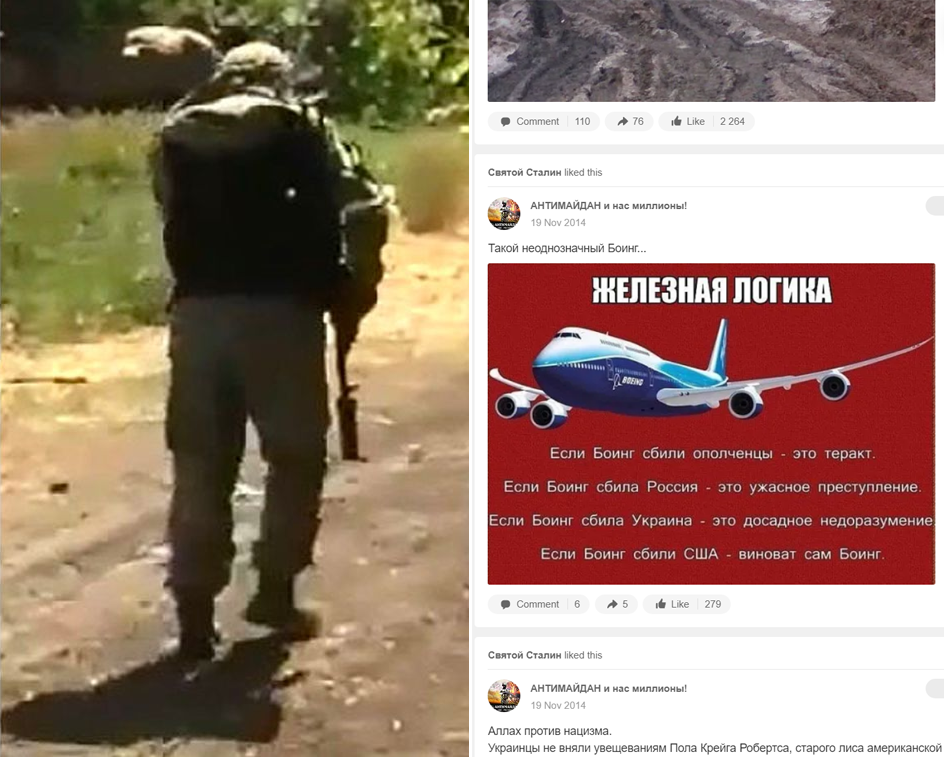
Left: Pulatov’s profile photo on his anonymous Odnoklassniki taken from the 16 July 2014 video with Strelkov, Borodai, and a Strela-10 missile launcher recorded close to the Buk missile launch site.
Right: A like by Pulatov on the same profile for an image with text referring to the downing of MH17.
Other posts by Pulatov on Glav.su, made since he became aware of the indictment against him, reveal that he continues to defend himself by spreading long-debunked conspiracy theories. In one of his recent postings, Pulatov explains that he does not give any comments to the media while the case continues, but at the same time shared links for the public to Russian and English versions of the YouTube series “MH17 Inquiry”, which uses poorly-constructed arguments claiming that the known videos of the Buk transport are actually elaborate forgeries, and that MH17 was actually shot down by a Ukrainian fighter jet. In another instance, after he was asked about the “deliberate falsifications present in the materials of the Joint Investigation Team”, Pulatov decided to lash out against both the JIT and Bellingcat:
“[…] let’s focus on the issue of expertise [in order to understand the] nature of the fraud… The problem with the JIT is that they take a brainless Bellingcat investigation for truth … The biggest issue is not even that it concerns a made-to-order investigation that relies on speculation … [but rather that] at the JIT and Bellingcat there’s not (even) a single person with Soviet military education! … A specialist would have told them about the “obvious blunder that casts doubt on the entire version of the investigation.”
It is not certain what Bellingcat investigation Pulatov refers to here, but the screenshot posted by Pulatov of his chat with a representative of the JIT shows that on the same day as the official indictment against him (19 June 2019) he was reading the Bellingcat report “A Birdie is Flying Towards You: Identifying the Separatists Linked to the Downing of MH17” released that same day.
This report explains how we were able to confirm Pulatov’s identity and discuss his possible involvement in guarding the Buk at the launch site. We confirmed this information by examining Pulatov’s online activities, reconstructing the chain of command of the so-called GRU DNR, and by analyzing the only publicly released phone intercept related to Pulatov in which Kharchenko is told that “Gyurza” (Pulatov’s military call sign) will join him at the eventual launch location near Pervomaisky (which casts doubt on his claim that he was stationed in the Stepanivka area when MH17 was downed).
More importantly, it later became clear that the JIT had collected much more incriminating evidence against Pulatov than is available from open sources. For example, the official indictment document mentions an unpublished phone intercept in which Dubinsky hands out instructions to Pulatov. At the start of the trial, the prosecutor also mentioned the existence of “intercepted telephone conversations” that Pulatov has participated in, which suggests they have more recordings of him. Also, when they discussed the verification of visual material, the prosecutors stated that “findings by other parties, such as the research collective Bellingcat, were always carefully verified through our own investigative processes”.
One can only guess what Pulatov means with the “obvious blunder that casts doubt on the entire version of the investigation”, though the fact that he mentions the need for Soviet military education might suggest that he was thinking about the chain of command within the Russian Armed Forces (whose structure is largely inherited from the Soviet Armed Forces). More recently, Pulatov also posted an image on the chain of command of Russian air defense at the time of hostilities, information that he might be willing to invoke to argue that the Buk crew could technically not have been his subordinates.
The crew members are indeed suspected of having consisted of Russian officers and soldiers of the Russian Armed Forces (with members of the 2nd division of the 53rd Anti-Aircraft Brigade from Kursk being particularly suspect). In the Bellingcat report “Potential Suspects and Witnesses from the 53rd Anti-Aircraft Missile Brigade” (2015), we had collected a large amount of information on Buk commanders of the 2nd division and explained that the decision to launch a missile normally lies with a commissioned officer with the rank of lieutenant (page 63).
However, with the unconventional nature of the conflict in the Donbas and Russia’s covert military operations in eastern Ukraine, it appears that the rules regarding the chain of command were already broken on the day of the downing — a Buk missile launcher normally operates only when there are other Buk system vehicles nearby (including, most importantly, the Snow Drift target acquisition radar which would have allowed for easier identification of airplanes), but these were never seen in Ukraine as the remainder of the 53rd Brigade is believed to have stayed behind in Russia. It is therefore difficult to say whether Pulatov or his colleagues in the so-called GRU DNR could have given direct orders to a Russian Buk crew to shoot down an aircraft.
Regardless of who gave the command to shoot down MH17, the prosecutors have argued that the defendants should still be held accountable for the crime simply because they had requested and organized its deployment of this system near the frontline.
The crew of the Buk TELAR pressed the button, but according to the indictment it was Girkin, Dubinsky, Pulatov, and Kharchenko who directed the employment of this weapon in order to serve their own interests. They were in command of others; they directed the Buk to the launch location; they talked during intercepted communications about the need for a Buk to serve their cause and whether “their” Buk had done its job; they noted with delight that an aircraft has been shot down; they direct others in the delivery of the system to the launch site and they organise the removal of the Buk TELAR to the Russian Federation. When it comes to evidence and responsibility, as of now no other suspects in the investigation are in the same position as Girkin, Dubinsky, Pulatov, and Kharchenko.
New details about the cooperation between the DNR and the Buk crew are contained in the summons document from the prosecution service, in which it is revealed that the four defendants are also charged with providing the Buk crew with a mobile phone number and a Ukrainian SIM card for easier communication. These details fit with the evidence already established that the Buk crew consisted of fresh arrivals from Russia, and that there was a clear intent that the DNR would coordinate air defense with them. In other words, though the DNR described themselves as an organisation independent from the Russian Armed Forces, they obviously had a common task and directive.
New evidence that the separatists were present at the launch site also comes from witness M58, described by the prosecutors as a Russian volunteer separatist who was stationed with his unit at “at a crossroads south of Snizhne, in the vicinity of a Buk” at the moment a missile was launched (this crossroad likely concerns a checkpoint next to the launch site which we also described in our report on page 47). The witness has testified that both Russian military personnel and separatists were present at the launch site.
The exact role that Pulatov played in the downing of MH17 has not been clearly detailed in public information, but the June 2019 indictments contain a description of the unreleased phone intercept between Pulatov and Dubinsky in which Dubinsky instructs him to “receive” the Buk from Kharchenko and to guard the missile launcher at the eventual launch site near Pervomayskiy.
Some confusion still exists over what Pulatov’s title was at the time: the prosecutors described him as the deputy head of the so-called GRU DNR, but according to our investigation (pages 58, 61, 72) Pulatov was the head of the 2nd division (special forces) within the GRU DNR, which included Kharchenko’s reconnaissance battalion (in a forum post from 28 September 2015, Pulatov himself also stipulated that he was not a deputy but the head of the 2nd division). In both cases, however, Pulatov would have held a more senior position than Kharchenko, meaning that he was likely the highest ranking separatist with the missile launcher at the launch site.
On the second day of the proceedings, the Dutch prosecutors asked Pulatov’s defense if Pulatov, who is currently living in Russia, is willing to give testimony before the court, but his lawyers explained that more time is needed for such a decision to be made. If he claims his right to remain silent before the court, it remains to be seen if Pulatov will also stop posting comments about the case on public forums, and if his lawyers are willing to defend the conspiracy theories that Pulatov keeps invoking.
Sergey Dubinsky, the chief coordinator of the Buk deployment
In our previous reports, we identified Russian citizen and (former) GRU officer in the Russian Armed Forces Sergey Dubinsky as the chief coordinator of the Buk transport in DNR-controlled territory. Dubinsky is also the person who initially requested the deployment of this anti-aircraft system to support Russian-backed troops along the frontline south of Snizhne. As the head of the so-called GRU DNR, both Pulatov and Kharchenko were Dubinsky’s subordinates.
At the trial, the prosecutors announced they had obtained more intercepted phone conversations with Dubinsky from September and October 2014, in which he was negotiating a prisoner exchange with the Ukrainian side. In one of these conversations, dated 27 September 2014, he is asked about his involvement in the downing of MH17 (the intercepted conversations from 17 July were by then already published on the internet, but Dubinsky’s identity was not publicly known yet), to which Dubinsky responded as follows:
“When the toy [Buk] was being moved around, got it. I mean the one, which was moved across the Republic’s area. Yes. It really features my voice. But it does not mean that someone was shooting [it] down.”
As the 17 July recordings feature him coordinating the transport of the missile launcher through the territory of the so-called DNR, Dubinsky seems to admit here that it was his voice on the phone recordings and that there was indeed a Buk on the territory of the so-called DNR. The prosecutors have also stated that the person who talked with Dubinsky on these recordings confirmed that he had taken part in these conversations.
This would not have been the first time that Dubinsky admitted that his voice can be heard on the intercepted conversations from July 2014. Like Pulatov, Dubinsky has sometimes commented on the downing of MH17 on public online forums; for example, in a post from 2 August 2015 he admitted that the recording from the morning of 17 July 2014 in which he is informed about the arrival of the Buk missile launcher and its crew in Donetsk is authentic.
One person who was involved in the prisoner exchange on the Ukrainian side was Sergey Tiunov, a former friend and comrade-in-arms of Dubinsky. Having by then already recognized Dubinsky’s voice on the published intercepts (before his identity was known to the world), he recalled how he confronted Dubinsky regarding the downing of MH17, who then responded with: “You don’t think that I did this [myself], do you? The bastards from Moscow did it!”
However, if Dubinsky indeed only wants to blame the Russian side for the downing of MH17, the prosecutors still hold him responsible for planning the operation. In the summons it is stated that the four defendants are also charged with:
“…requesting and/or ordering (or letting another request and/or order) the provision of a (Russian) air defence system (with crew) [and] announcing (or letting another announce) the need for air defence for the armed struggle of the so-called Donetsk People’s Republic (around Stepanivka and Marynivka [south of Snizhne]) to the commander(s) and/or crew of that BUK TELAR.”
In one intercepted conversation from a day before the downing, Dubinsky can be heard expressing his wish to receive a Buk the next morning to support his troops fighting on the frontline south of Snizhne. Furthermore, in a recording from the morning of 17 July, Dubinsky orders Kharchenko to take the Buk to the village of Pervomayskiy, which is right next to the farmland where the missile launch would take place later that day.
Last year, Dubinsky again commented on the phone intercepts during an interview with Yana Yerlashova, a former employee of Russian state-funded outlet RT who created a short documentary on the MH17 case that attempts to cast doubt on the official investigation by the JIT. This time, Dubinsky admitted that it was his voice on the phone intercepts, but claimed that the recordings have been edited by the SBU. He did not elaborate on the supposed editing other than stating that an intercepted conversation between him and “Botsman” (whom we identified as Russian citizen Sergey Povalyaev) supposedly took place one day before the downing of MH17. However, in our previous publications we had already indicated that some of the details in the call indicate that the conversation took place shortly after the downing of MH17:
- Dubinsky is heard saying “Yesterday two Sushkas were shot down, today the second”, which is consistent with the following facts: 1) On 15 July, the Ukrainian Air Force did not lose any aircraft; 2) On 16 July, one Ukrainian Su-25 attack aircraft was hit and another was downed over the frontline south of Snizhne; 3) after the 16 July shootdown, the Ukrainian Air Force would not lose anymore aircraft until 23 July 2014; and 4) after the downing of MH17, Dubinsky was informed over the phone by Kharchenko that a Sukhoi jet was shot down (i.e. MH17)
- Dubinsky is heard saying “I’ll go to Donetsk in two hours, because there is another delivery for me there — three Gvozdikas. I’ll bring the Gvozdikas here because it’s really fucking hard for us to hold on”, and based on several livetweets three Gvozdikas (Soviet self-propelled howitzers) indeed drove from Donetsk into the direction of Snizhne in the evening of 17 July.
- Dubinsky is heard saying “Thank god, at least the Buk-M arrived this morning [so] things became easier”, and the only Buk that Dubinsky’s GRU DNR is known to have received is the one that arrived in the morning of 17 July and was used to shoot down MH17.
Dubinsky may have anyway unknowingly incriminated himself in this interview by admitting that it is indeed his voice on this recording, as he can clearly be heard saying that a Buk had arrived for them that morning. On other occasions the DNR leadership publicly lied by stating that there never was such a weapon in their territory.
Sergey Dubinsky is currently still living a relatively comfortable pensioner’s life in Russia and does not appear to take the trial seriously. This is probably most illustrative from the photos and videos released to the public of him at a boat party together with former Russian separatist leader and GRU officer Igor Bezler, and (former) GRU officer Vasily Geranin — (both feature in a well-known published intercept in which Bezler reports to Geranin that a plane had been shot down which later turned out to be MH17). A video of the same scene shows them joking around and bringing a toast to Igor Girkin.
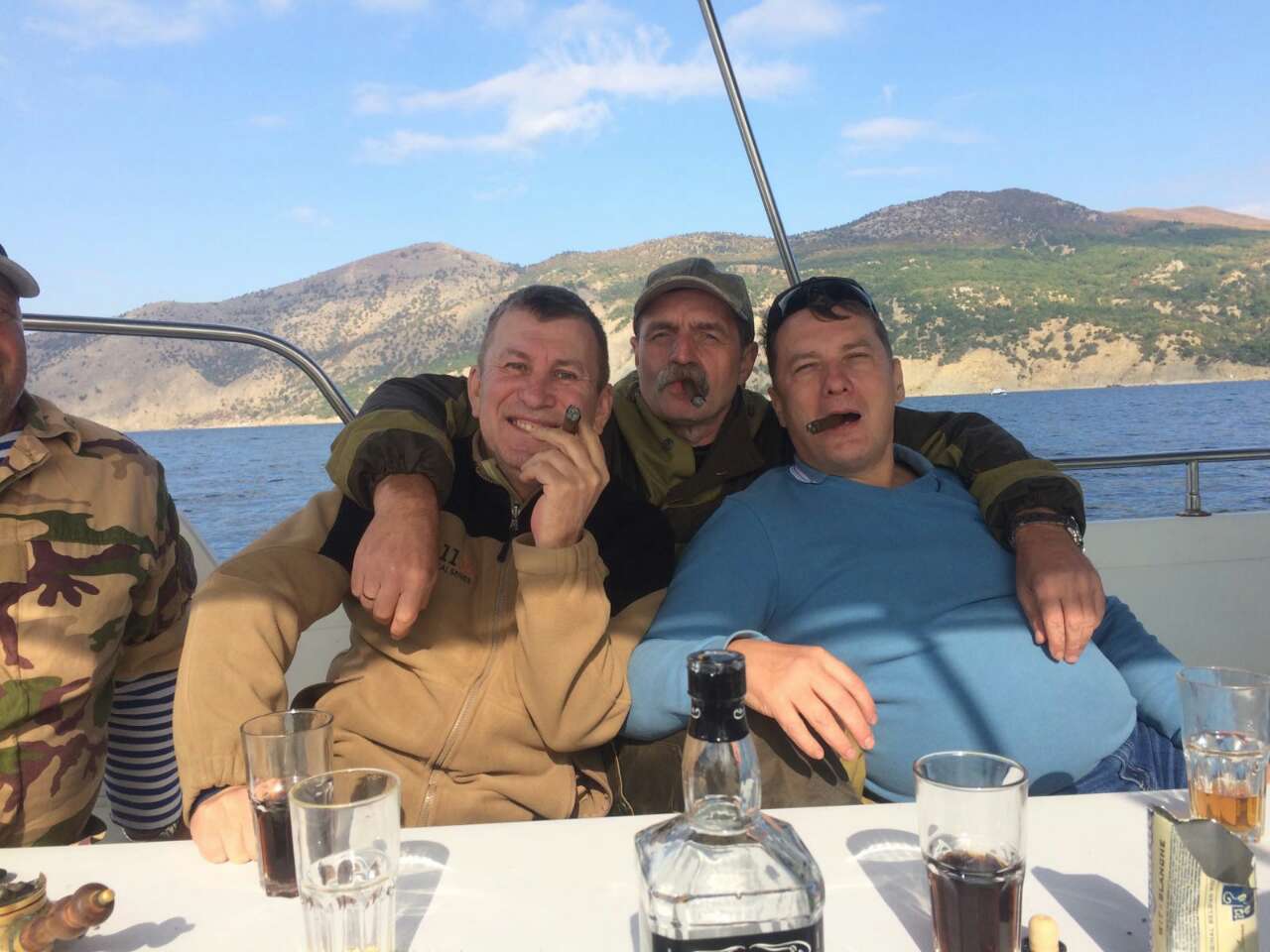
Happy times. From left to right: Sergey Dubinsky, Igor Bezler, and Vasily Geranin on a boat trip in Russian-annexed Crimea on 27 October 2019
Igor Girkin (a.k.a. Igor Strelkov), the former Defense Minister of the DNR
When it was announced in June 2019 that Russian citizen and former FSB colonel Igor Girkin was also indicted for the downing of MH17, the Dutch prosecutors released new evidence that he had already requested air defense systems with trained soldiers from the Russian side as early as 8 June 2014. This was not surprising, as before then it was clear Girkin must have had knowledge about the arrival of the Buk missile launcher simply because he was the Defense Minister of the so-called DNR as well as a close ally of his subordinate Dubinsky who had coordinated the Buk transport.
Nevertheless, what Girkin was up to himself on the day of the downing remained unclear — the phone intercepts published by the SBU only reveal that he was involved (together with Dubinsky and Kharchenko) in the removal of the Buk back to Russia.
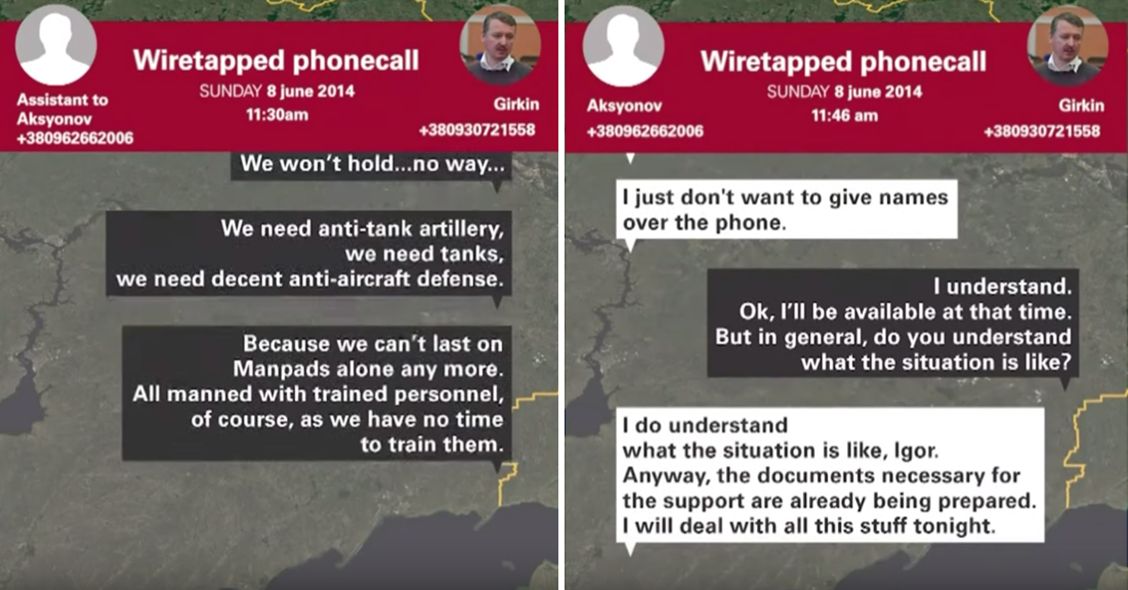
Parts of the conversations between Girkin and Sergey Aksyonov plus Aksyonov’s assistant from 8 June 2014 in which Girkin can be heard requesting high-altitude anti-aircraft systems with trained personnel
During the court hearings new evidence that Girkin’s DNR army was involved in the downing of MH17 was presented in the form of testimony that Girkin himself had given to the Russian authorities in February 2015 (further details of why this happened and how the prosecutors managed to obtain this statement were not revealed):
“On 17 July 2014, at about 16.30 Moscow time, the commander of a people’s militia unit with the alias ‘Kep’ – currently the deputy Minister of Defence of the Donetsk People’s Republic; I don’t remember his personal details because we called each other by aliases – reported that the air defence had hit one of the two Su-25 aircraft of the Ukrainian air force. This occurred in the area to the north of the town of Snezhnoye. […] About an hour after the report concerning the SU-25 fighter aircraft being hit, that is about 17.30, I received a message from the city of Gorlovka, Ukraine, that an unknown aircraft had crashed in the immediate vicinity of the aforementioned city.”
According to the prosecutors, Girkin must have been talking about the downing of flight MH17 here as this was the only aircraft shot down in Ukraine that day, and also because he received this message just ten minutes after the downing of MH17. They seem to have missed that Girkin’s testimony mentions that he was informed about the shootdown of a Sukhoi Su-25 aircraft at “16.30 Moscow time”, and not Kyiv time, while the downing of MH17 took place at 16:20 Kyiv time / 17:20 Moscow time.
It could easily be that time zones were somehow mixed up in this testimony, as the differences in time zones and summer time regulations between Russia, Ukraine, and the so-called DNR were changed in 2014. However, because no other aircraft was shot down that day, and because the phone intercepts reveal that Kharchenko also initially reported to Dubinsky that a Sukhoi jet had been shot down, it is clear that Girkin was indeed talking about the downing of MH17.
The person with the call sign “Kep” that Girkin speaks about is Sergey Velikorodny (b. 30.01.1976), a Russian citizen who in July 2014 was a separatist commander at the Snizhne front. On 23 July 2014 (one week after the downing of MH17), Sergey “Kep” Velikorodny appeared in an item aired by the Russian pro-Kremlin news channel LifeNews claiming responsibility for the downing of two Ukrainian Su-25 fighter aircraft which crashed south of Snizhne that day.
Velikorodny also features in an intercepted conversation with Girkin that was released by the Ukrainian Ministry of Internal Affairs on 30 July 2014 as part of the mounting evidence that the Russian Armed Forces were by then conducting cross-border artillery strikes on Ukrainian positions (in this recording, Girkin informs “Kep” that his troops stationed in the vicinity of Shakhtarsk will be “covered from the south by Russian artillery”).
One of Velikorodny’s subordinates was reportedly Vladimir Tsemakh, the commander of the air defense in both Semyonovka and Snizhne who was arrested by the Ukrainian authorities as an MH17 suspect, but later released as part of a prisoner swap with Russia. Tsemakh had incriminated himself by accidentally confessing on camera that he was involved in hiding the Buk after the downing of MH17, which makes him, at the very least, a key witness to the case.
So far, the prosecutors have not charged anyone for the removal of the Buk back to Russia (which, according to the published intercepts, also involved Girkin, Dubinsky, and Kharchenko). However, the prosecutors also stated that Tsemakh is still considered a suspect whose extradition from the Russian Federation has been requested and that they have not yet decided “whether Tsemakh will be prosecuted” as the “investigation into his role has not yet progressed to the point where such a decision can be made”.
Girkin himself has announced on multiple occasions that he does not recognize the authority of the Dutch court on the matter of MH17. His previous comments on this case have included denials and passing the blame onto others for the downing, though sometimes with additional hidden defense arguments in between. For example, during a press conference on 11 September 2014, Girkin stated the following:
“They only link the separatists to the downing of the Boeing because it crashed on territory which by then was partially, I repeat, controlled by the [DNR] militia. I don’t know who shot down the Boeing, as I have been commanding military operations and didn’t have time to investigate [this case]. But my own guess is that the Ukrainian side shot down the Boeing and had organized this in advance as a massive provocation, because all the facts indicate that the Boeing was specifically sent there, and the Ukrainian side created all the conditions for [an accidental] shootdown. Well, most likely, then, after finding out that things didn’t work out, they themselves shot it down. Otherwise, the world media would have been pestering us about it in full force.”
Thus, while Girkin hinted at, but did not fully embrace, the conspiracy theory in which Ukraine downed the plane in an apparent false flag attack, he seemed more eager to allege that Ukraine deliberately directed the plane over the conflict area in the hopes that there would be an accidental shootdown from his side of the conflict. However, the argument that MH17 changed route has actually already long been debunked, as all data indicated that the plane did not divert from its flight path at all and there was no unusual behavior from air traffic control on the day of the downing.
Nevertheless, the argument contains an important detail: by insinuating that the Ukrainian side was hoping that Donbas-based militants were stupid enough to accidentally shoot down a passenger airliner if it flew towards Snizhne, it assumes that they would have known that the separatists had an anti-aircraft weapon capable of shooting down an airliner flying at a cruising altitude. Yet, Russian officials and other DNR leaders have consistently denied that there was a Buk missile launcher in DNR territory that day. Girkin himself never went this far — in an earlier press conference from 28 July 2014, he only stated “I didn’t have any Buk installations under my command. Therefore, I couldn’t have given them orders to shoot at the Malaysia Airlines airplane’.
In comments made by Girkin after he returned to Russia in August 2014, he also only denied the involvement of the DNR in the downing of MH17, whilst refusing to comment on who else is to blame. For example, in an interview with The Insider from 8 December 2017, Girkin was asked who he believed was responsible for the downing, and answered “What I think I will keep for myself. If I live for another 20 years, [you can] wait for my memoirs” — a response which suggests he is carrying secrets. The interviewer responded with “That’s an interesting answer, because if it was simply Ukrainians that shot down the Boeing, you would probably say that”, to which Girkin responded: “I repeat — no comment”.
Girkin would generally continue his silence after his indictment by the court in The Hague was announced, though in a comment from a public chat on VK from 17 November 2019 he repeated the theory that MH17’s flight route had been changed and also hinted that the leadership in Moscow was partially responsible for the downing:
“In The Hague they expect only me and three more uninvolved [in the downing of MH17]. No one there is asking for VVP [i.e. Vladimir Vladimirovich Putin]. Nor about those who changed the Boeing’s route from Kyiv towards Snizhne.”
In the same chat, Girkin answers all questions from his followers except one in which he is asked about whether the Boeing was shot down by a Ukrainian Buk. More recently, when asked by the BBC about the Dutch court case and if he knew who shot down MH17, Girkin answered “Let me repeat once again, the [DNR] militia didn’t shoot down the Boeing, I have nothing more to say”. When he was subsequently asked if this means the plane was shot down by Russian soldiers instead, he again refused to answer and ended the interview.
It is possible that Girkin does know or believe that that Russian servicemen, not his DNR forces, are primarily to blame for the downing, since he would be one of the first to know that it was a Russian Buk operated by Russian soldiers that shot down MH17. However, for obvious reasons, this is likely not something that the current regime in Russia would allow him to admit without repercussions. Girkin’s unwillingness to deny Russian involvement fits with the public image he has worked to cultivate — the image of someone with integrity who speaks the truth even about controversial matters. He has remained uniquely taciturn about the downing of MH17 while he has been quite open and talkative on most all topics around war, including admissions of torture and extrajudicial execution.
For example, after Girkin was accused in 2014 by human rights activists of possible involvement in forced disappearances in the Chechen mountain village of Khatuni back in 2001, Girkin confirmed that he was stationed in this village at the time and implied that he faced a hostile “local Chechen population”. Also, in at least two interviews, Girkin was willing to admit that he used extrajudicial punishment during the Battle of Sloviansk in order to stop looting (the executions, as he justified it, were carried out under a Stalin-era military law).
On other occasions, Girkin has shown he is willing to reveal facts that go against typical narratives espoused in Russian propaganda. For example, in an interview on 22 January 2015, Girkin explained that the overwhelming local support in Crimea for “self-defence” as portrayed by the Russian media during the 2014 annexation (in which he participated) was largely fictional, and that they actually had to “forcibly drive the deputies to vote” in favour of joining Russia.
Igor Girkin currently lives a relatively comfortable life in Moscow, where he enjoys celebrity status. Although he does not seem to take the trial seriously and continues to deny that the DNR militia was involved in the shooting down of MH17, the available evidence suggests he can still be convicted as a co-conspirator, even if the Buk crew entirely consisted of Russian servicemen.
The recent indictments reveal that the defendants are also charged with: “requesting and/or ordering (or letting another request and/or order) the provision of a (Russian) air defence system (with crew)”, something that Girkin can be convicted for also because of his 8 June 2014 request for advanced anti-aircraft systems manned with trained personnel from the Russian side. Certainly, Girkin would have only wanted this missile launcher deployed to protect his forces from Ukrainian military aircraft, but the prosecutors have also stated: “The Buk-TELAR that downed flight MH17 should never have been in Ukraine, and it should never have fired a missile there, whether aimed at a civilian or military aircraft”.
